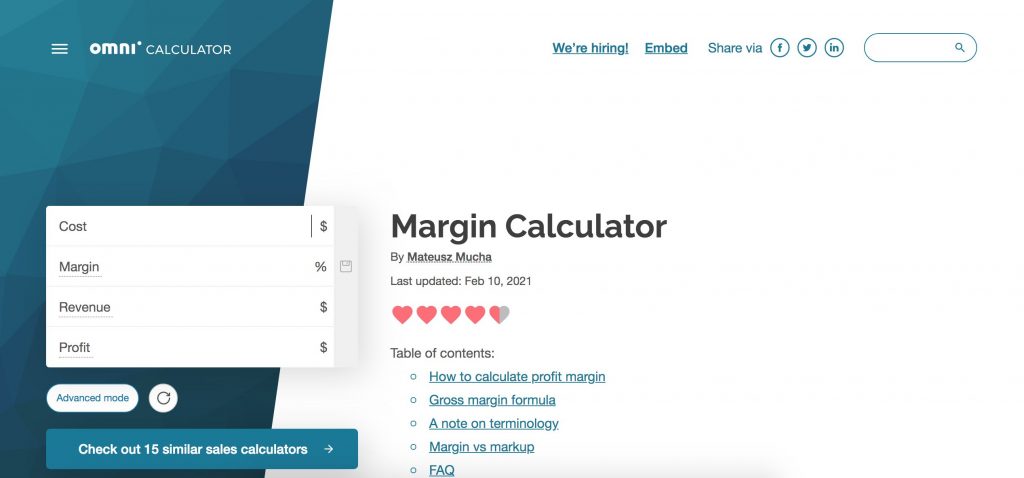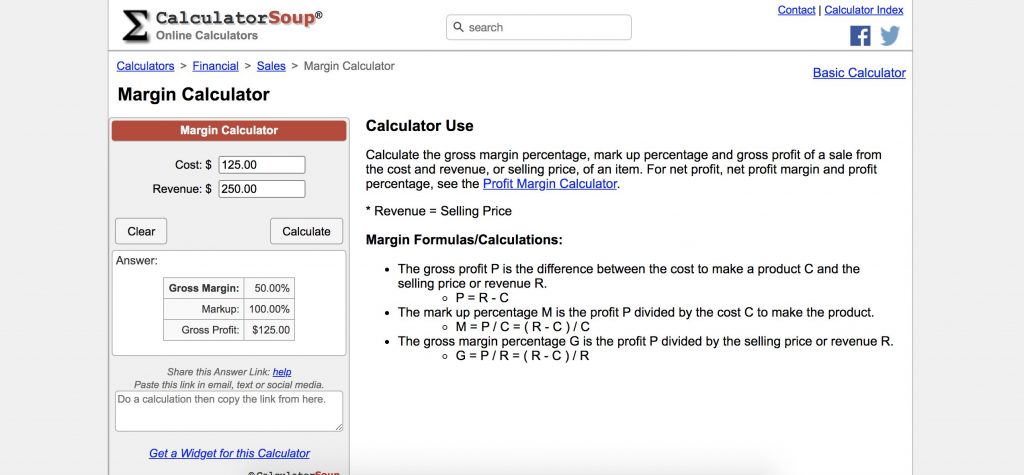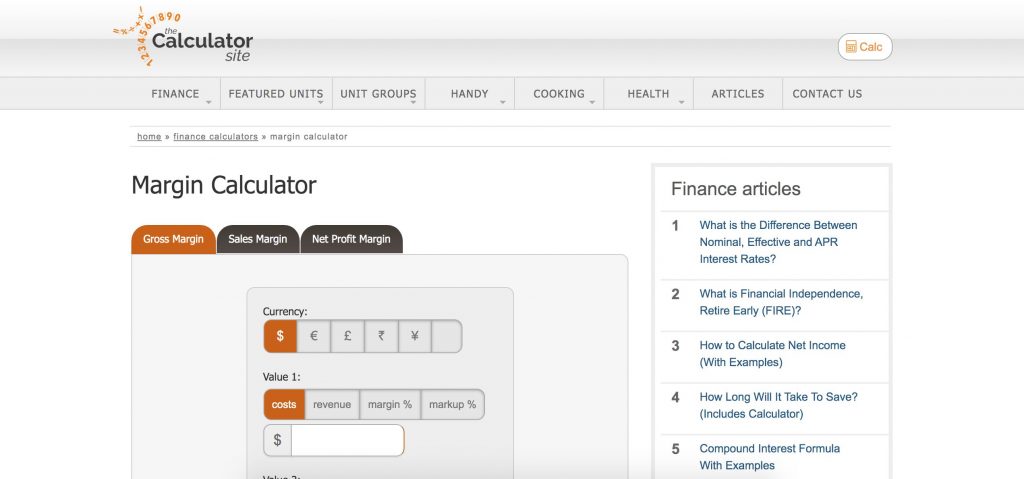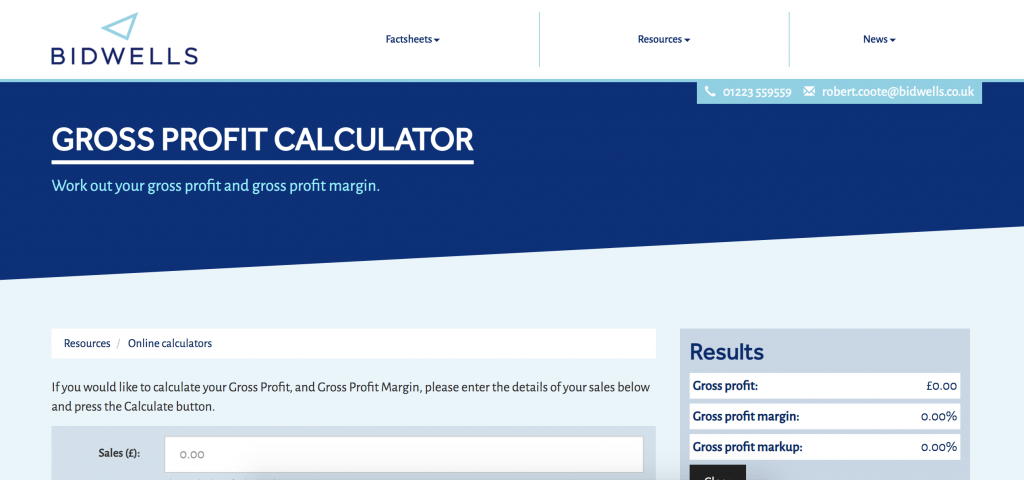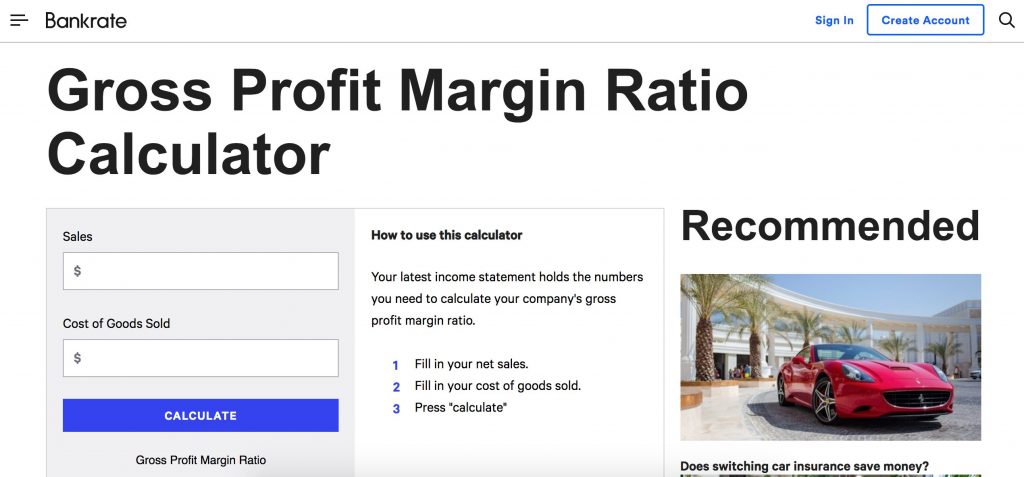Businesses looking to grow will need to be aware of their financial journey, and just how much money they’re making. One way to do this? Keep track of your profit margin. A profit margin is a way to measure how much your company is earning. You may also know it as calculating your profits, in relation to your revenue.
Your profit margin will determine how much profit your business generates for each dollar of sale. For example, if you have a 50 percent profit margin, you’ll be netting an income of $0.40 for each dollar of sales.
A profit margin can be an excellent way to keep track of your company’s health; it can guide you to make better business decisions and resolve financial issues quickly.
Plus, a great profit margin will make your business more attractive to potential investors. Your profit can be an important way to track your progress and your business’ financial success. Whether you want to calculate it by yourself, or use an online calculator, here are the resources you will need to make sure your business is sailing smoothly.
What Is a Profit Margin?
There are three main metrics relating to profit margins: gross, operating, and net. First is the gross profit margin, which is measured through total revenue minus the cost of goods sold (COGS). The operating profit margin, the second metric, is the revenue minus the COGS and operating expenses. The net profit margin is the revenue minus all expenses, including interest and taxes.
The Profit Margin Formulas
If you plan to calculate these profit margins manually, here are the formulas you would need to use in order to do it by hand. The differences between these can be quite significant.
A gross profit margin will measure your income after you account for your COGS. This measurement does not include overhead expenses like rent or utilities, though. Measuring your gross profit margin is one of the simplest ways to measure profit. Below, find a formula.
An operating profit margin will measure your profit margin taking into account your overhead expenses, operating expenses, and administrative expenses in your day-to-day operations. This calculation, while more thorough, does not include your business’ debt, taxes, and other day-to-day expenses that are related to your non-operational expenses.
A net profit margin is your bottom line, in business terms. This calculation will give you your total revenue left over once all of your expenses and income are taken into account. It’s also called an overall profit margin.
If you want to calculate these yourself, here are the standard formulas:
Gross Profit Margin = Gross Profit / Revenue x 100
Operating Profit Margin = Operating Profit / Revenue x 100
Net Profit Margin = Net Income / Revenue x 100
What’s a Good Profit Margin?
Especially if your business is new, you may be wondering, what exactly is a good profit margin? A “good” profit margin is subjective to a number of factors, particularly your industry and the type of business you run.
However, a good measure of a solid, average profit margin is about a 10 percent net profit margin. For many, a 20 percent margin will be considered higher than normal. Alternatively, a 5 percent margin is quite low.
It’s important to remember that these guidelines are only a rule of thumb, and solid profit margins will vary greatly industry to industry. Your company size will also play a role.
The Best Profit Margin Calculators
If you don’t plan on calculating your profit margin yourself, don’t worry, you’re not alone. There are plenty of online resources to help you calculate your profit margin without having to do the math yourself.
The Omni Calculator
The Omni calculator is a free online tool that helps you calculate your profit margin when taking into account an item’s revenue. The calculator will also take into account cost of goods sold (how much you paid for the stuff that you sell), profit margin, revenue (how much you sell it for) and profit. The site also has a VAT calculator, a sales tax calculator and half a dozen more.
Calculator Soup
Calculator Soup is another free online tool that helps you calculate your gross profit margin. You can also determine your mark-up percentage and gross profit of a sale from the cast and revenue of an item.
The Calculator Site
The Calculator Site has three free calculators: a gross profit margin calculator, a sales margin calculator, and a net profit margin calculator, all for free. The online calculator has a number of customizations for businesses, too.
BKL
The BKL online calculator is another free tool to calculate your business’ gross profit margin and your gross profit calculator.
Oberlo
Calculating your profit margin has never been easier with the Oberlo online calculator. It’s more simplistic than other options, for sure, but it does help you calculate your baseline measure of profitability.
Shopify
The Shopify profit margin calculator is a simple, free way to determine what prices to sell your products, in order to maximize your profits and increase your profit margin.
Bidwells
Determine your gross profit and your gross profit margin using this free Bidwells online calculator. By putting in your information, the calculator will determine your gross profit, gross profit margin, and gross profit markup.
NCalculators
NCalculators is home to a number of calculators, from date and time calculators to net profit calculators. In addition, you can calculate gross profit margin, rate of return, fixed asset turnover, email marketing ROI, and more.
Bankrate
This free Bankrate calculator will allow you to calculate your gross profit margin ratio. However, it’s quite basic compared to other options and will only calculate your gross profit margin ratio.
How Else Should You Calculate Company Success?
Before you take your profit margin too seriously, remember that any good business owner will take into account a number of factors when determining the success of a company. If you’re planning to evaluate your company’s performance, consider examining these performance metric factors as well:
- Return on Equity (ROE)
- Internal Rate of Return (IRR)
- Cash Flow Yield
- Return on Assets (ROA)
- Revenue Growth Rate
- Dividend Yield
- Net Present Value (NPV)
Now, which one of these your company values as a measure of success will depend on your brand and your industry. For example, one company may value Cash Flow Yield, while others will value Dividend Yield more. Key metrics will be substantially different from your competitors.
Conclusion
When determining the performance and success of your company, it’s important to take a greater look at the factors that contribute to success in addition to your profit margin. Profit margin can give you a great look at your cash flow and financial journey, but it’s just one part of the success of your company.
Frequently Asked Questions
What’s the easiest way to calculate a profit margin?
A profit margin is a way to measure how much your company is earning. Here’s the easiest and most simple way to calculate a profit margin. First, determine your business’ net income. You can find that by subtracting expenses from revenue. Then, you will divide your net income by your revenue, or net sales. Once you have that number, multiply your total by 100 to get your profit margin percentage.
What is a 60% profit margin in cash?
To calculate a 60% profit margin, you will need to follow the gross profit margin formula. In order to do this, use the formula: Gross Profit Margin = Gross Profit / Revenue x 100. Here’s how it works. If your company has $1,000 in revenue and its COGS is $400, the gross profit margin is (1,000 - 400) = $600. When you divide the result by $1,000, revenue will equal .6, or 60 percent.
What is a good profit margin?
Especially if your business is new, you may be wondering, what exactly is a good profit margin? A “good” profit margin is subjective to a number of factors, particularly your industry and the type of business you run. However, a good measure of a solid, average profit margin is about a 10 percent net profit margin. For many, a 20 percent margin will be considered higher than normal. Alternatively, a 5 percent margin is quite low.
How can you calculate your annual profit margin?
There are three ways to calculate your annual profit for your business. here are the standard formulas:
- Gross Profit Margin = Gross Profit / Revenue x 100
- Operating Profit Margin = Operating Profit / Revenue x 100
- Net Profit Margin = Net Income / Revenue x 100
What’s the easiest way to calculate a profit?
There are three main metrics relating to profit margins: gross, operating, and net. Here’s the easiest and most simple way to calculate a profit margin. First, determine your business’ net income. You can find that by subtracting expenses from revenue. Then, you will divide your net income by your revenue, or net sales. Once you have that number, multiply your total by 100 to get your profit margin percentage.
